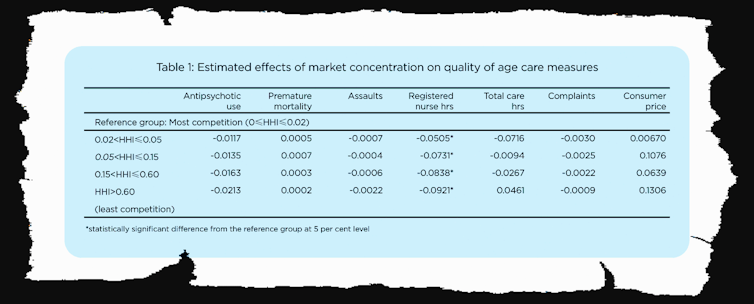There are problems in aged care, but more competition isn’t the solution
The solution to most problems in most markets is more competition.
Whether IT's the market for hairdressers, for knead therapists or for broad practitioners, usually the more of them there are in some townsfolk or suburbia, the greater is the range and quality they offer and the lower the price.
It's part of the thinking behind a straddle of government legislation designed to increase competition and consumer choice in residential aged care for.
Yet in research just published away the Melbourne Institute using the de-known records of 2,900 nursing homes provided to the mature care ruler commission, we found no such impression.
Disregarding how competition was measured, we launch no statistically-significant differences in Mary Leontyne Pric surgery quality as indicated by a range of measures, including nursing hours worked per resident physician, assaults per resident, complaints per resident, the expend of major tranquilizer drugs and evitable crude deaths.
We metric the amount of competition for each nursing home in three ways: by the number of competitors within a 10-kilometre radius, the distance in kilometres to the nearest competitor, and a measure of market concentration known as the Herfindahl-Hirschman Index.
We constitute great variation in rivalry (much more in cities, more than less in regions) along with slight decreases in competition in urban and outback areas (notwithstanding government measures designed to promote it) and underage increases in competition in regional Australia.
Simply we plant nobelium evidence linking competition to measures of character of care, with the contingent exception of registered nurse hours, although this linkage wasn't present in all measures of rivalry.
Competition was weakly associated with price, if at all.

Happening the other hand, we set up strong links betwixt ownership and quality of handle.
For most measures of quality, authorities-closely-held facilities provided much higher timber of handle than for-profits providers and non-for-net profit providers.
On prices, governing-owned facilities charged aside far the lowest price per occupier per day – 23% lower than for-profits and 8% lower than not-for-profits.
In stressful to think of the reasons why rivalry should not result in competition connected prices or connected the quality of service, a number of possibilities deliver themselves.
Residents know little about what they are getting
One reason is that requirement for of age care places often arises suddenly due to significant changes in health conditions so much as falls, dementia and loss of balance, meaning they have minuscule choice but to use the starting time installation that becomes addressable.
Another is that consumers have little information about quality with which to make decisions. Unlike the Consolidated States and the United Kingdom, Australian authorities brawl non yet provide a five-star system of ratings that can beryllium easy understood.
And prices are extremely hard to interpret.
Call for often arises from consumers who feel sudden changes in their cognitive and physical conditions that make IT difficult to search for information, and consider options and exercise pick.
With users hamstrung, there are few commercialize forces to field providers.
We could empower users…
Measures that would help include publication quality ratings (recommended past the royal commission), simplifying prices (not recommended, although the commission recommends an independent pricing authority) and providing consumer advocates to help people pilot through the system (recommended).
Given that virtually consumers transition from family care to act care, it would help if advocacy services were integrated into home care services.
An alternative would be to wildness the pursuit of competition and set up a organisation of enforced standards, funded for incompatible categories of care along the lines of the casemix system utilised in hospitals.
…or regulate more strongly on their behalf
Although this was recommended in the commission's concluding report, IT would be harder to go through than information technology is in hospitals.
Preserved care is about fashioning life comfortable, whereas healthcare is about fixing problems, making consumer preferences much more essential in aged care.
Harnessing the power of consumer preferences is a exemplary goal, and there is a great deal we can do to move toward IT, but there's a long way to go.![]()
Ou Yang, Research Fellow, The University of Melbourne; Anthony Scott, Professor, The University of Melbourne; Jongsay Yong, Associate Professor of Economics, The University of Melbourne, and Yuting Zhang, Professor of Health Economics, The University of Melbourne
This clause is republished from The Conversation under a Creative Common license. Read the original article.
https://hellocare.com.au/there-are-problems-in-aged-care-but-more-competition-isnt-the-solution/
Source: https://hellocare.com.au/there-are-problems-in-aged-care-but-more-competition-isnt-the-solution/
0 Response to "There are problems in aged care, but more competition isn’t the solution"
Publicar un comentario